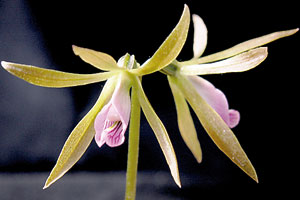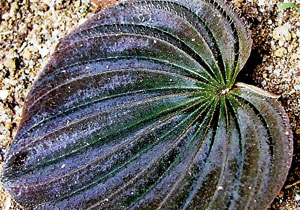In the midst of a study, researcher Ajantha Palihawadana was puzzled by a strange looking plant in a home garden in Koswatte. It had only one leaf. Recognizing it as a ground orchid, though different from others he had seen, he placed it in a pot in his garden waiting for it to bloom.
A few months later, the leaf died. But knowing the strange behaviour of some orchids, Ajantha marked the pot and kept it aside.
A few months later, he was thrilled to see a flowering shoot emerge from the soil. And when, the flowers bloomed, the plant’s true beauty was seen. Scientifically categorized as Nervilia Plicata –it was the first confirmed record of this species from Sri Lanka.
 |
| Nervilia Plicata : An orchid recorded
from tropical Asia |
 |
| This large leaf dies after a few months |
Nervilia Plicata is an orchid recorded from tropical Asia and growing in India. This finding confirmed its presence in Sri Lanka too updating the National Orchid checklist to 189.
Nervilia Plicata has some special characteristics. The width of its hairy heart shaped single leaf can be from 7.7cm to 10.8cm. The leaf can look dark green or dark purple depending on the angle of exposure to light.
This large leaf dies after a few months, but its rhizome (the horizontal stem of the plant) survives underground. Then during March, April and May – the flowers appear. Nervilia Plicata produces two flowers usually a foot above the ground, a mix of purple and green and about 6 centimetres in diameter. Unlike most orchids, this flower also has a fragrance but lasts only four to five days.
Ajantha said there had been several specimens of Nervilia orchids deposited in the National Herbarium previously, but they were not properly identified. However, for the first time, now a complete specimen has been deposited in the herbarium, so that other scientists too can observe the species.
The study of wild orchids is time-consuming but also rewarding, says Dr. Suranjan Fernando, another scientist involved in orchid research. Sri Lanka has epiphytic orchids that usually grow on trees, terrestrial orchids, climbing orchids and also saprophytic orchids. Saprophytic orchids, like Nervilia that live on dead organic matter such as leaf litters are also interesting as they do not have any leaves and only a flower. They depend on fungi for their entire supply of nourishment. Most orchid flowers also had different adaptations to attract different kind of pollinators, Dr. Fernando said.
Such interlinks also make the wild orchids threatened. For, if a specialized pollinator insect has been removed from the ecosystem by extensive use of pesticide etc, the orchids lose means of pollination. But the main threat remains habitat loss, says Dr. Fernando pointing out that most of the orchid rich habitats such as Uva Savannah, the Peak Wilderness, Morningside of Sinharaja are being progressively degraded.
IUCN’s National Red List of Threatened Flora & Fauna of Sri Lanka published in 2007 also paints a gloomy picture for orchids as it records 4 extinct species, 22 critically endangered and 47 endangered plants out of the reviewed species.
Director of Sri Lanka Botanical Gardens Department Dr.Siril Wijesundara said that Sri Lanka has lost about 83% of her wildlife habitat during the last two centuries and if the remaining habitats are not protected, it will have a serious impact on our beautiful orchids. These highly specialized and sensitive plants are extremely vulnerable to ecosystem changes.
Some of our orchid species including the beautiful, endemic Vanda thwaitesii have not been seen in Sri Lanka for more than a century, he said.
Nervilia Plicata habitats are also threatened, adds Ajantha Palihawadana adding that studies done by True Nature Conservation Society led by himself found the plant also in Ravana Ella and Balangoda. According to the records, this orchid is restricted to the savannah ecosystems in the Intermediate Climatic Zone where trees are scattered in grasslands.
The wet patches located in this area are the home of this orchid, but unfortunately this is also one of the highly threatened habitats in Sri Lanka.
Dr.Wijesundara points out that the collection of rare orchids from the wild by hobbyists is on the increase and needs immediate control. Many also remove wild orchids to their home gardens, but these orchids need special habitats and conditions, and will die or will not flower the way they do in the wild so are best left untouched. |



